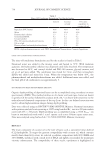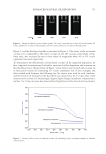707 UV OXIDATION of catechin compounds and caffeine (Figure 4), whereas extracts with low ORAC scores contained lower levels of these compounds. A correlation between the ORAC scores and the identified components showed that (−)-epicatechin and procyanidin B had the largest correlation coeffients, and most catechins in the tea samples significantly correlated (p 0.001) with the ORAC scores (31). HAIR UV BIOMARKER EXPERIMENTS Previously published work has shown that the exposure of hair to UV radiation produces protein damage (2) and that MALDI time-of-flight (TOF) mass spectrometry (MS) can be used to identify specific fragments that correlate with total protein damage and UV Figure 4. Protection from damage as measured by UV biomarker intensity (m/z 1,278). *, p 0.05 versus UV-only, Student’s t-test. Reproduced with permission from Scientific Research Publishing, Inc. (31). 1 2 3 4 5 6 7 8 9 10 11 12 13 14 15 Time (min) 0 50000 100000 150000 200000 250000 300000 1 2 3 4 5 6 7 8 9 10 Figure 4. Chromatogram of tea sample BIC 29465. Major compounds: 1,gallocatechin 2,(−)-epigallocatechin 3, (+)-catechin 4, caffeine (procyanidin B peak lies behind this peak) 5, epigallocatechin gallate 6, (−)-epicatechin 7, gallocatechin gallate 8, (−)-epigallocatechin-3-(3″-O-methyl) gallate 9, (−)-epicatechin gallate 10, (−)-catechin gallate.
708 JOURNAL OF COSMETIC SCIENCE exposure (8). Specifically, a marker peptide at m/z 1,278 was identified as a fragment of the S100A3 protein known to be involved in cuticle cell adhesion (32). Hair treated with four of high activity tea extracts was exposed to UV radiation and compared to hair with no treatment exposed to UV radiation and hair with no UV exposure. After UV exposure the protein biomarker at m/z 1,278 was extracted in water and quantified by MALDI-TOF MS. A significant increase in biomarker peak intensity was measured for hair that had been pretreated with tea extracts, illustrating a protective benefit. The magnitude of this benefit was correlated to the concentration-adjusted ORAC score (R2=0.98) CONCLUSION The UV oxidation of proteins entails complex chemistry involving reactive oxygen species, and tracking this chemistry in hair is extremely challenging. Our approach has been to use a model colloidal system incorporating tyrosine, a key amino acid involved in UV-induced protein damage. Using this colloidal system, we identified the roles of oxygen, reactive oxygen species, and redox metals such as iron in the oxidation of tyrosine. Also demonstrated with this model system was the ability to decrease oxidation through the addition of antioxidants such as BHT. Experiments on hair were performed with selected botanical extracts of tea (C sinensis) that contain polyphenols such as catechins that are efficient radical scavengers as demonstrated by high ORAC scores. The efficacy of tea extracts was found to correlate with the level of tea compounds and with the levels of catechins and procyanidins, highlighting the importance of understanding botanical extract phytochemistry when assessing antioxidant performance. The highest-efficacy tea extracts were shown to prevent UV damage to hair proteins as measured by a reduction in the formation of a protein biomarker (m/z 1,278). ACKNOWLEDGEMENTS The authors thank The Procter & Gamble Company for funding support of this work. REFERENCES (1) T. Evans and R. R. Wickett, Eds., Practical Modern Hair Science (Allured Publishing Corporation, Carol Stream, IL, 2012). (2) C. M. Pande and J. Jachowicz, Hair photodamage: measurement and prevention, J. Soc. Cosmet. Chem., 44, 109–122 (1993). (3) E. Hoting and M. Zimmerman, Photochemical alteration in human hair. Part III: investigation of internal lipids, J. Soc. Cosmet. Chem., 47(4), 201–211 (1996). (4) W. Korytowski, B. Pilas, T. Sarna, and B. Kalyanaraman, Photoinduced generation of hydrogen peroxide and hydroxyl radicals in melanins, Photochem. Photobiol., 45(2), 185–190 (1987). (5) J. M. Dyer, S. D. Bringans, and W. G. Bryson, Determination of photo-oxidation products within photoyellowed bleached wool proteins, Photochem. Photobiol., 82(2), 551–557 (2006). (6) L. J. Kirschenbaum, X. Qu, and E. T. Borish, Oxygen radicals from photoirradiated human hair: an ESR and fluorescence study, J. Cosmet. Sci., 51(3), 169–182 (2000). (7) K. R. Millington and L. J. Kirschenbaum, Detection of hydroxyl radicals in photoirradiated wool, cotton, nylon and polyester fabrics using a fluorescent probe, Color. Technol., 118(1), 6–14 (2002).
Purchased for the exclusive use of nofirst nolast (unknown) From: SCC Media Library & Resource Center (library.scconline.org)






































































































































